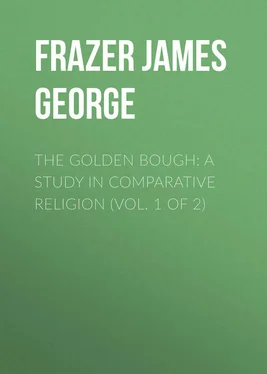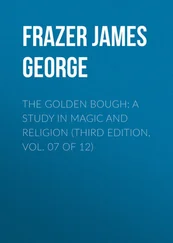James Frazer - The Golden Bough - A Study in Comparative Religion (Vol. 1 of 2)
Здесь есть возможность читать онлайн «James Frazer - The Golden Bough - A Study in Comparative Religion (Vol. 1 of 2)» — ознакомительный отрывок электронной книги совершенно бесплатно, а после прочтения отрывка купить полную версию. В некоторых случаях можно слушать аудио, скачать через торрент в формате fb2 и присутствует краткое содержание. Жанр: foreign_religion, foreign_antique, foreign_prose, на английском языке. Описание произведения, (предисловие) а так же отзывы посетителей доступны на портале библиотеки ЛибКат.
- Название:The Golden Bough: A Study in Comparative Religion (Vol. 1 of 2)
- Автор:
- Жанр:
- Год:неизвестен
- ISBN:нет данных
- Рейтинг книги:4 / 5. Голосов: 1
-
Избранное:Добавить в избранное
- Отзывы:
-
Ваша оценка:
- 80
- 1
- 2
- 3
- 4
- 5
The Golden Bough: A Study in Comparative Religion (Vol. 1 of 2): краткое содержание, описание и аннотация
Предлагаем к чтению аннотацию, описание, краткое содержание или предисловие (зависит от того, что написал сам автор книги «The Golden Bough: A Study in Comparative Religion (Vol. 1 of 2)»). Если вы не нашли необходимую информацию о книге — напишите в комментариях, мы постараемся отыскать её.
The Golden Bough: A Study in Comparative Religion (Vol. 1 of 2) — читать онлайн ознакомительный отрывок
Ниже представлен текст книги, разбитый по страницам. Система сохранения места последней прочитанной страницы, позволяет с удобством читать онлайн бесплатно книгу «The Golden Bough: A Study in Comparative Religion (Vol. 1 of 2)», без необходимости каждый раз заново искать на чём Вы остановились. Поставьте закладку, и сможете в любой момент перейти на страницу, на которой закончили чтение.
Интервал:
Закладка:
It is hardly necessary to illustrate the custom of setting up a village May-tree or May-pole on May Day. One point only – the renewal of the village May-tree – requires to be noticed. In England the village May-pole seems as a rule, at least in later times, to have been permanent, not renewed from year to year. 289 289 Hone, Every-day Book , i. 547 sqq. ; Chambers, Book of Days , i. 571.
Sometimes, however, it was renewed annually. Thus, Borlase says of the Cornish people: “From towns they make incursions, on May-eve, into the country, cut down a tall elm, bring it into the town with rejoicings, and having fitted a straight taper pole to the end of it, and painted it, erect it in the most public part, and upon holidays and festivals dress it with garlands of flowers or ensigns and streamers.” 290 290 Quoted by Brand, op. cit. i. 237.
An annual renewal seems also to be implied in the description by Stubbs, a Puritanical writer, of the custom of drawing home the May-pole by twenty or forty yoke of oxen. 291 291 Id. , op. cit. i. 235.
In some parts of Germany and Austria the May-tree or Whitsuntide-tree is renewed annually, a fresh tree being felled and set up. 292 292 Mannhardt, B. K. p. 169 sq. note .
We can hardly doubt that originally the practice everywhere was to set up a new May-tree every year. As the object of the custom was to bring in the fructifying spirit of vegetation, newly awakened in spring, the end would have been defeated if, instead of a living tree, green and sappy, an old withered one had been erected year after year or allowed to stand permanently. When, however, the meaning of the custom had been forgotten, and the May-tree was regarded simply as a centre for holiday merrymaking, people saw no reason for felling a fresh tree every year, and preferred to let the same tree stand permanently, only decking it with fresh flowers on May Day. But even when the May-pole had thus become a fixture, the need of giving it the appearance of being a green tree, not a dead pole, was sometimes felt. Thus at Weverham in Cheshire “are two May-poles, which are decorated on this day (May Day) with all due attention to the ancient solemnity; the sides are hung with garlands, and the top terminated by a birch or other tall slender tree with its leaves on; the bark being peeled, and the stem spliced to the pole, so as to give the appearance of one tree from the summit.” 293 293 Hone, Every-day Book , ii. 597 sq.
Thus the renewal of the May-tree is like the renewal of the Harvest-May; each is intended to secure a fresh portion of the fertilising spirit of vegetation, and to preserve it throughout the year. But whereas the efficacy of the Harvest-May is restricted to promoting the growth of the crops, that of the May-tree or May-branch extends also, as we have seen, to women and cattle. Lastly, it is worth noting that the old May-tree is sometimes burned at the end of the year. Thus in the district of Prague young people break pieces off the public May-tree and place them behind the holy pictures in their rooms, where they remain till next May Day, and are then burned on the hearth. 294 294 Reinsberg-Düringsfeld, Fest-Kalendar aus Böhmen , p. 217; Mannhardt, B. K. p. 566.
In Würtemberg the bushes which are set up on the houses on Palm Sunday are sometimes left there for a year and then burnt. 295 295 Birlinger, Volksthümliches aus Schwaben , ii. 74 sq. ; Mannhardt, B. K. p. 566.
The eiresione (the Harvest-May of Greece) was perhaps burned at the end of the year. 296 296 Aristophanes, Plutus , 1054; Mannhardt, A. W. F. p. 222 sq.
So much for the tree-spirit conceived as incorporate or immanent in the tree. We have now to show that the tree-spirit is often conceived and represented as detached from the tree and clothed in human form, and even as embodied in living men or women. The evidence for this anthropomorphic representation of the tree-spirit is largely to be found in the popular customs of European peasantry.
There is an instructive class of cases in which the tree-spirit is represented simultaneously in vegetable form and in human form, which are set side by side as if for the express purpose of explaining each other. In these cases the human representative of the tree-spirit is sometimes a doll or puppet, sometimes a living person; but whether a puppet or a person, it is placed beside a tree or bough; so that together the person or puppet, and the tree or bough, form a sort of bilingual inscription, the one being, so to speak, a translation of the other. Here, therefore, there is no room left for doubt that the spirit of the tree is actually represented in human form. Thus in Bohemia, on the fourth Sunday in Lent, young people throw a puppet called Death into the water; then the girls go into the wood, cut down a young tree, and fasten to it a puppet dressed in white clothes to look like a woman; with this tree and puppet they go from house to house collecting gratuities and singing songs with the refrain —
“We carry Death out of the village,
We bring Summer into the village.” 297 297 Reinsberg-Düringsfeld, Fest-Kalendar aus Böhmen , p. 86 sqq. ; Mannhardt, B. K. p. 156.
Here, as we shall see later on, the “Summer” is the spirit of vegetation returning or reviving in spring. In some places in this country children go about asking for pence with some small imitations of May-poles, and with a finely dressed doll which they call the Lady of the May. 298 298 Chambers, Book of Days , i. 573.
In these cases the tree and the puppet are obviously regarded as equivalent.
At Thann, in Alsace, a girl called the Little May Rose, dressed in white, carries a small May-tree, which is gay with garlands and ribbons. Her companions collect gifts from door to door, singing a song —
“Little May Rose turn round three times,
Let us look at you round and round!
Rose of the May, come to the greenwood away,
We will be merry all.
So we go from the May to the roses.”
In the course of the song a wish is expressed that those who give nothing may lose their fowls by the marten, that their vine may bear no clusters, their tree no nuts, their field no corn; the produce of the year is supposed to depend on the gifts offered to these May singers. 299 299 Mannhardt, B. K. p. 312.
Here and in the cases mentioned above, where children go about with green boughs on May Day singing and collecting money, the meaning is that with the spirit of vegetation they bring plenty and good luck to the house, and they expect to be paid for the service. In Russian Lithuania, on the 1st of May, they used to set up a green tree before the village. Then the rustic swains chose the prettiest girl, crowned her, swathed her in birch branches and set her beside the May-tree, where they danced, sang, and shouted “O May! O May!” 300 300 Mannhardt, B. K. p. 313.
In Brie (Isle de France) a May-tree is set up in the midst of the village; its top is crowned with flowers; lower down it is twined with leaves and twigs, still lower with huge green branches. The girls dance round it, and at the same time a lad wrapt in leaves and called Father May is led about. 301 301 Ib. p. 314.
In Bavaria, on the 2d of May, a Walber (?) tree is erected before a tavern, and a man dances round it, enveloped in straw from head to foot in such a way that the ears of corn unite above his head to form a crown. He is called the Walber , and used to be led in solemn procession through the streets, which were adorned with sprigs of birch. 302 302 Bavaria, Landes-und Volkskunde des Königreichs Bayern , iii. 357; Mannhardt, B. K. p. 312 sq.
In Carinthia, on St. George's Day (24th April), the young people deck with flowers and garlands a tree which has been felled on the eve of the festival. The tree is then carried in procession, accompanied with music and joyful acclamations, the chief figure in the procession being the Green George, a young fellow clad from head to foot in green birch branches. At the close of the ceremonies the Green George, that is an effigy of him, is thrown into the water. It is the aim of the lad who acts Green George to step out of his leafy envelope and substitute the effigy so adroitly that no one shall perceive the change. In many places, however, the lad himself who plays the part of Green George is ducked in a river or pond, with the express intention of thus ensuring rain to make the fields and meadows green in summer. In some places the cattle are crowned and driven from their stalls to the accompaniment of a song —
Интервал:
Закладка:
Похожие книги на «The Golden Bough: A Study in Comparative Religion (Vol. 1 of 2)»
Представляем Вашему вниманию похожие книги на «The Golden Bough: A Study in Comparative Religion (Vol. 1 of 2)» списком для выбора. Мы отобрали схожую по названию и смыслу литературу в надежде предоставить читателям больше вариантов отыскать новые, интересные, ещё непрочитанные произведения.
Обсуждение, отзывы о книге «The Golden Bough: A Study in Comparative Religion (Vol. 1 of 2)» и просто собственные мнения читателей. Оставьте ваши комментарии, напишите, что Вы думаете о произведении, его смысле или главных героях. Укажите что конкретно понравилось, а что нет, и почему Вы так считаете.












